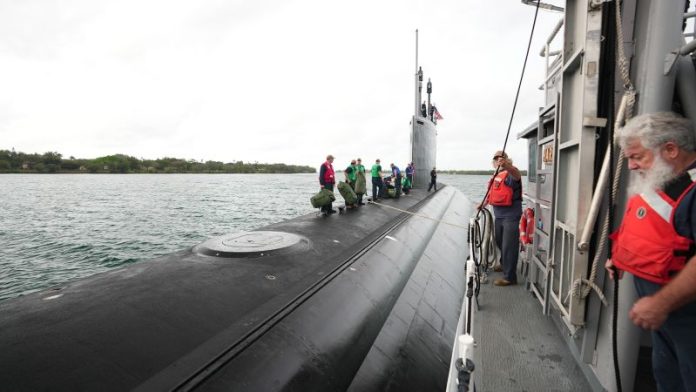Hundreds of feet below the surface of the Pacific Ocean, cocooned within one of the U.S Navy’s most technologically advanced pieces of equipment, Rear Admiral Jeff Jablon is clear-eyed about the two biggest challenges his team faces.
“In today’s world, we are facing two nuclear peer adversaries where we’ve never had that before,” he explains on board the USS Mississippi, a nuclear-powered, fast-attack submarine belonging to the U.S Pacific Fleet.
“The Soviet Union – and now Russia – was our peer adversary with respect to nuclear capability. We’re now facing China, which has expanded and modernised their nuclear capabilities.”
Earlier that day the Virginia-class submarine had left its base at Pearl Harbour in Hawaii and slipped below the waves into the world’s largest ocean on a routine mission.
Throughout the vessel some 130 sailors were at their stations carrying out a host of well-honed tasks.
In the control room more than a dozen sailors were on duty, some looking for obstacles on sonar, others charged with navigating in the dark depths.
Down in the torpedo room, technicians practiced loading weapons to ensure operational readiness at all times, engineers manned the lower floors to ensure the water and hydraulic systems were functioning properly.
It is cramped and claustrophobic work, where those on board describe long periods at sea and intense relationships, almost like a family.
“I see them every day, work with them every day, sleep right next to each other,” Jack O’Brien, a 22-year-old machinist from Massachusetts, says of his comrades.
“And even when we’re in port, we’re still here sunup to sundown working.”
As concerns over an accelerating nuclear arms race in Asia grow, a CNN crew was given exclusive access to the USS Mississippi, one of what Jablon said are 49 fast-attack submarines in the U.S fleet, to witness how Washington is stepping up preparations to deter a potential conflict in the region.
The role these vessels play – hard to spot, hard to destroy and able to travel vast distances – was given fresh impetus when earlier this month, the United States, the United Kingdom and Australia announced details of a nuclear-powered submarine deal that would see greater cooperation between the three countries to counter China’s rapid military expansion.
Under the so-called AUKUS deal, Australia will buy three Virginia-class submarines from the U.S in the early 2030s, pending congressional approval.
China has lambasted the agreement, accusing the three powers of engaging in “Cold War mentality” that will make the world less safe.
In November, the USS Mississippi made a port visit to the western Australian city of Perth, where it conducted training with members of the Royal Australian Navy, the U.S Defence Department said.
The U.S and its allies have also increasingly raised alarms over China’s growing military ambitions and territorial claims in the Western Pacific and the South China Sea.
Beijing’s ruling Communist Party has also refused to rule out the use of force in capturing Taiwan – a self-governing democracy of 23.5 million that it claims to be a part of its territory, despite having never ruled it.
Last month, a CNN crew was on board a U.S Navy reconnaissance jet above international waters in the South China Sea, when a Chinese fighter jet flew in close proximity to intercept it.
“The National Security Strategy outlines that the PRC is our pacing threat, and Russia is an acute threat to our country,” Rear Adm. Jablon, commander of Submarine Force, US Pacific Fleet, said, using an abbreviation for the People’s Republic of China.
“The majority of our submarine force is now located in the Pacific,” Jablon added. “At this point, about 60% of our (operational) submarines are located in the Pacific because of those challenges.”
Despite the advances made by the Chinese military, experts say the U.S still has a significant advantage when it comes to undersea warfare.
“Submarines are one area where the United States retains unchallenged superiority over China,” said Carl Schuster, a retired U.S Navy captain and former director of operations at the US Pacific Command’s Joint Intelligence Center in Hawaii.
“They are the one stealth platform with the striking power and survivability to counter the PLA Navy’s surface and subsurface forces,” Schuster said.
The Mississippi, like all US Navy submarines, is nuclear powered, which gives it essentially an unlimited range and time to be deployed, with it only needing to make port calls for provisions for its crew.
As Jablon put it: “All we need is food for individuals, and if we take enough food, we could go round the world without resupplying.”
Firing nuclear-armed missiles is a mission reserved for the Navy’s 14 ballistic missile submarines, larger vessels often referred to as “boomers.”
But what the USS Mississippi is armed with is still formidable – its class carries Tomahawk cruise missiles that can hit targets up to 1,000 miles (1,600 kilometers) away as well as torpedoes to strike adversaries on or below the sea.
When fully loaded, it can also carry up to 25 Mark-48 torpedoes – an advanced heavyweight torpedo that can strike adversaries on or below the sea, said Edward Barry, the commanding officer of USS Mississippi.
Jablon said the U.S submarine force has increasingly made its presence known to the general public and adversaries alike because it achieves a deterrent effect.
“We used to be known as the silent service during the Cold War, (we) never let anybody know where we were operating,” Jablon said.
“In today’s submarine force, we operate extensively with the rest of the United States services and with our allies. So the adversary knows we can operate in international waters anywhere on the world,” he added.
China has been massively expanding its navy in recent decades, but on nuclear-powered submarines it remains significantly behind the U.S, something Beijing is keen to change.
The numbers of China’s ballistic missile submarines and nuclear-powered attack submarines, now numbering six of each, are projected to more than double between 2020 and 2040, according to a 2022 Congressional Research Service (CRS) report on China’s naval modernisation.
Meanwhile, the PLA Navy is expected to maintain 44 diesel-powered/air-independent powered attack submarines, according to the US military.
Writing in the U.S Naval Institute’s journal Proceedings, Mike Sweeney, a PhD student at George Mason University, notes a numbers and scope problem for US Navy subs.
He says that U.S submarine technology remains superior to China’s, but it “may simply lack sufficient numbers” in any conflict with China.
Jablon, the rear admiral, gave some more details on how US Navy subs are dispersed.
Twenty-five of the fleet’s 49 attack subs are stationed in the Pacific, he said. But some of those subs – Jablon would not provide specifics – are unavailable for maintenance or other reasons, he said.
Some analysts say that could be up to two-thirds of the fleet.
“An old rule-of-thumb holds that for every vessel operating, two others are required — one preparing for deployment and a second standing down from recent operations,” Sweeney wrote in Proceedings.
Of course, China’s fleet would likely face similar maintenance demands, but it need only cover two oceans – the Pacific and Indian – giving the PLA Navy an advantage in the total number of subs in the Indo-Pacific.
Numbers from the U.S Congressional Budget Office point to another potential problem for U.S attack submarines – the fleet is expected to shrink to 46 boats by 2028, before new building programs fully kick in and bring the fleet to as many as 69 boats by 2052.
And last month, U.S Navy Secretary Carlos Del Toro told a House Appropriations subcommittee that construction of new Virginia-class submarines was “significantly behind” schedule, saying the building was occurring at a rate of 1.4 subs a year, well behind the planned two per year.
Life as a submariner can be unique from other branches of the military.
Because the submarine can be submerged deep inside the ocean for extended periods of time, the crew on board the USS Mississippi has to live in a small enclosed area with little communication with the outside world.
The crew is normally divided into three shifts to ensure the warship is manned 24 hours a day, ship commander Barry explains.
The daily routine on board a nuclear submarine is largely standardized: crew members are assigned to be on active duty for eight hours every day, followed by eight hours of studying, cleaning and socializing, before they are required to sleep.
“I think the United States’ greatest strategic asset is the people,” said Barry, who has served in the U.S Navy for 19 years.
“They’re well trained, well educated, they’ve got a lot of experience, and they’re patriotic. And that’s why I think few people can replicate when they put a vessel like this out to sea.”
Steven Wong, a 26-year-old electronics technician from California, said he was a bit shocked when he first joined the unit because of the tight space on board a nuclear submarine.
“What surprised me the most was how close you get with each other, these kinds of shared hardships and you end up with a really strong bond,” said Wong, who is responsible for operating the nuclear reactor to provide power and electricity.
Staying in touch with loved ones is no easy task given how hard it is to receive signals in the depth of the ocean.
“The only time we can really communicate is through email at periscope depth,” said Wong, whose wife lives in Hawaii. “Every day I try to get to my unclassified computer to get my email. It’s always super excited when I get to see that unread message,” said Wong.
SOURCE: CNN/PACNEWS














